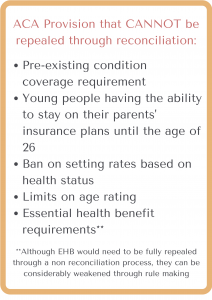Congressional action on the ACA (and also potentially Medicaid) has been coming fast and furiously – there’s almost too much to keep up with! Today, I’m going to attempt to explain the reconciliation process, but first, if you haven’t read the other blog posts in this series, you can go back and check them out here and here.
Since the new Congress convened in January, the news has been awash with buzzwords like “budget resolution”, “reconciliation”, “fiscal targets”, and “reconciliation directives”. But what do all of those things mean? And why do they matter to health care?
Reconciliation is a process established by the Congressional Budget Act of 1974 and was originally conceived as a way to reign in spending and potentially enact cuts to entitlement programs that had historically been difficult for politicians to cut.
This process has been relied on with increasing frequency as Congress has become more divided. Before we can jump into the particulars of reconciliation, let’s take a quick look at how the federal budget process normally works.
In a normal budget process the president submits a budget request to Congress. Both chambers of Congress then pass a budget resolution. Once the resolution is passed, appropriation committees in both chambers markup both bills before they go to the floor. Once on the floor, each chamber votes to pass their chamber’s version. If the two versions are different, a conference committee is convened where the differences in each bill are reconciled. Once those differences are reconciled, the bill is sent back to both chambers of a final vote. The final step is the President’s signature. In a regular budget process, sixty votes are needed in the Senate to achieve cloture, which effectively ends debate (and any attempt at filibuster) so a vote can take place. While the budget itself does not need sixty votes to pass, something called cloture is required before a final vote can be taken and cloture requires 60 votes. Cloture is essentially a vote to end debate on a subject and move to amendments and final vote on the bill in question. Without 60 votes to invoke cloture, debate on a topic can continue indefinitely until cloture happens.
While the actual piece of legislation only requires a majority to pass, getting to the portion of the process where the bill can be given an up or down vote requires 60 votes.

Reconciliation is a way to fast track that budget process and bypass the 60 votes that are needed for cloture. The major advantage of using the reconciliation process instead of the traditional process that legislation goes through is that there is no cloture vote required, so all it takes is 51 votes to pass the bill out of the Senate. Reconciliation starts with a budget resolution that includes reconciliation instructions. The budget resolution only contains broad outlines of the policy that will eventually result from the process of reconciliation, but the important thing it does is to give instructions to the appropriate committees in both the House and the Senate to draft legislation that deals with the topic or topics outlined in the budget resolution. Once those committees draw up the appropriate language, the bill can work it’s way through the typical bill process (committee markup and vote and then onto the floor) but it doesn’t have to. Legislation created as the result of instructions found inside of a budget resolution can go straight to the floor. Once the bill is on the floor, debate is limited to 20 hours, but the amendment process is theoretically unlimited. There are occasionally agreements between both parties to limit the number of amendments offered.
Now that I’ve bored you with a Congressional procedure lesson, what does all of this have to do with the ACA, Medicaid and what’s happening now?

There are several pieces of the ACA that can be repealed using the budget reconciliation process because they directly pertain to the budget. Changes to the way Medicaid, both the expansion and block granting or per capita caps, can also be made using this process for the same reasons. Any potential replacement elements that Congress wanted to include as part of reconciliation would have to have a direct effect on federal spending. This means that any replacement pieces that are not pertinent to the budget will have to go through the standard legislative process and will require 60 votes for cloture in the Senate.
Both chambers of Congress have already passed a budget resolution that includes reconciliation instructions related to health care spending. The appropriate committees were instructed to have legislative language completed last Friday, January 27th. As expected, we are still waiting. The important thing to know is that we are still at the point in the process where Congressional leaders are shaping what they want any changes to the ACA and/or Medicaid to look like. It is also important to know that some features of a replacement plan will likely need 60 votes and some cooperation from the minority party in order to pass.
The really important thing, though, is that there is still time to make your voice heard! Have the ACA and Medicaid impacted your life? Share your story here!